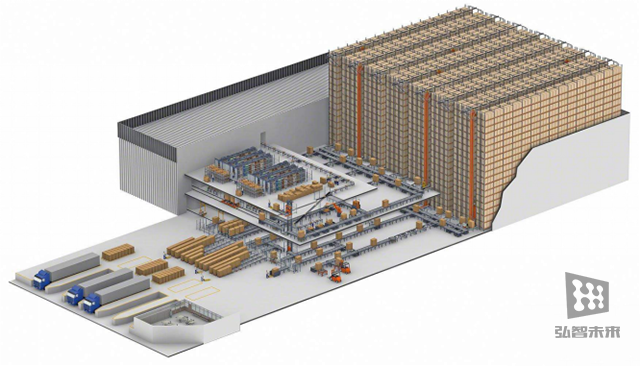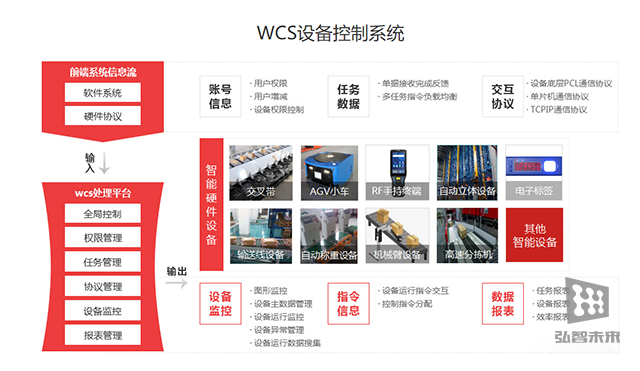WCS system design
Time:2022-04-11 08:01:28
Smart warehousing is a link in the logistics process. The application of intelligent warehousing can effectively improve the overall warehouse operation efficiency, ensure the speed and accuracy of data input in all aspects of goods warehouse management, ensure that enterprises can grasp the real data of inventory in a timely and accurate manner, and can easily control the batch, Manage the shelf life, reduce the generation of sluggish materials, and improve the inventory turnover rate, thereby greatly improving the informatization, intelligence and automation level of the warehouse, and creating more profits for the enterprise. As one of the typical automated logistics warehousing equipment, automated three-dimensional warehouses are more and more widely used in various industries. It replaces traditional flat warehouses and shelves, and increases the available storage on the same floor area by making full use of the space height. Through the rapid movement of stackers and forks, convenient access from objects to people is realized; through the supporting information management system, the work efficiency and informatization degree of warehouse and material management are improved. The main body of the automated three-dimensional warehouse is composed of shelves, stackers, conveyors and operation control systems. AGV trolleys can be introduced to complete the circulation and handling tasks of pallets or bins, which improves the automation of the entire system and can simultaneously complete material storage and retrieval. and information storage. Among them, the operation control system is mainly composed of WCS and WMS, which plays a leading role in the automatic three-dimensional warehouse system.

WCS is the abbreviation of Warehouse Control System. WCS is a layer of management control system between WMS system and PLC system. It exchanges information with the WMS system, receives the instructions sent by the WMS system, performs calculation and task priority allocation, and sends it to the PLC system, thereby driving the automated three-dimensional warehouse and conveying equipment to trigger corresponding mechanical actions. It can collect the status and data of the PLC system in real time and reflect it on the software interface, which is convenient for users to manually operate and monitor the real-time status of the equipment. WCS usually consists of two parts: WCS server and WCS workstation. The server is responsible for information interaction with WMS or other systems, and is also responsible for maintaining the background database. As the core control system of the automated three-dimensional warehouse, the workstation is responsible for sending execution instructions to the relevant mechanical equipment and obtaining the real-time status of the equipment, and reporting it to the server in time.

Architecture of WCS
The overall architecture of the WCS system is constructed from top to bottom using a four-layer structure, which are application layer, service layer, function layer and data layer.
Application layer: The application layer is responsible for the presentation of the user interface and the display of data information, as well as the entry of some control functions, and does not process business logic or data operations. The application layer is mainly designed for UI and client-side development to realize the access and interaction of users, business processes and back-end data.
Service layer: The communication with the equipment needs to build a PLC communication service to complete the reading of PLC status information and the writing of operation instructions; the database access service completes the recording and reading of the internal management and control information of the system; the realization of visual Kanban requires resources File reading, writing and loading services; WCS interacts with external upper management systems (WMS, ERP, MOM, MES, etc.) or control systems (PDA, RFID, PAD, LED, etc.) for information exchange and instruction issuance, and completes services through external system interfaces. In the process of task decomposition, combined with the characteristics of its own equipment and on-site logistics environment, the tasks of stacker, transmission line and AGV are regarded as three independent units of a complete task, which are combined and coordinated according to the actual situation. In the process of device debugging and user later use, the function and performance of the WCS system were tested and analyzed, and the user experience was partially optimized and adjusted through the combination of actual operation in the user's real use environment and the way of writing test cases. . The services of the service layer for PLC information acquisition are based on PLC communication services, and are independently developed for specific functional process services, including PLC communication, path planning, task generation and decomposition, warehousing document services, storage location storage services, electronic label services, etc. Features. Integrate the above functions and form general functional services. The overall level takes the functional process as the basic unit and is developed for specific businesses. This process requires the use of the communication components of the services, so that each service makes itself available to other services for use.
Function layer: Combined with specific business logic, it operates for specific device tasks, and is responsible for processing the data model of the access service call, completing data management and application function implementation. This layer mainly completes the core business functions, and at the same time connects the device control actions in series, completes the interaction between the device and the software function, and performs logical processing and command response for different functional requirements. According to the needs of customers and the action process of the equipment, the modules are divided according to each independent structure and functional unit of the equipment. The module that controls the movement of the conveyor line and the stacker is the internal transmission module; the part that controls the shape detection and weighing is the detection module. ; The module that controls the AGV is the handling module.
Data layer: Collect data for PLC status points and create persistent data models for service access and function calls. Store and manage database object entities, and complete the mapping between programming objects and database tables. The data layer is the interface for system data access and operation, including database storage and resource file storage. The database is built with SQL Server, and uses Redis for caching and remote dictionary services. Generalized encapsulation is carried out for the operations of the two databases to form database operation components for each function module to call.
WCS function module
WCS realizes that daily operations such as warehouse entry and exit, allocation, inventory transfer and inventory count can be carried out stably and efficiently, and can cope with the situation of multi-user collaborative use and cross-ordering of tasks, which promotes customers' informatization construction and intelligent production.

System management: including user role creation and account password management, role authority assignment and configuration, system storage and storage operation log record and query, equipment alarm record browsing and retrieval, for storage and storage frequency, bin usage frequency, equipment alarm frequency and other data statistic chart.
Basic management: including user management, role management, and authority management. User management can add, delete, modify, and check the basic information of system users. The super administrator account can manage ordinary operating users, and ordinary operating users can modify their own passwords. Role management enables administrators to divide and assign roles to common users, such as administrators, operators, and auditors. Permission management combines role management to limit and categorize user behaviors, such as the allocation of access permissions for trays, and the access restrictions for operating function entrances.
Storage location management: It is to serialize and manage all storage locations of the current automated three-dimensional warehouse, define and divide the flat storage shelves and virtual cargo areas outside other equipment, and use unified coding rules to define and identify. When recommending the storage location, according to the status and location of each location, it can cooperate with AGV and stacker to complete route optimization. Combined with user permissions, user allocation and status changes can be performed for storage locations, and the "disable" and "enable" functions can be used to specify whether a pallet can be placed in a certain location. For inbound and outbound operations.
Equipment monitoring module: including the overall layout top view dynamic diagram, the real-time position monitoring of the horizontal movement of the stacker, the real-time height display of the hoist, the display of the control mode, the distribution of the warehouse storage space, the status of the bin or pallet, and the display of some key PLC status points. Equipment monitoring realizes the display of the current task queue, the display of the real-time status of all hardware equipment, the real-time display of user operation trajectories, and the visualization of the overall movement status of logistics equipment. Benefiting from the good compatibility of this design architecture, when choosing the implementation method of the overall visualization system, both two-dimensional and three-dimensional methods can be used for development. Since there are many stackers involved in this project, and the stackers take into account many roadways, the two-dimensional top view is used for display, and the user can observe the real-time position and moving speed of each hardware device. Initiation of manual in-out and out-of-storage tasks, block the roadway, control the movement of the conveyor, and perform overall recovery of the equipment alarm.
Parameter setting module: including cargo position initialization and disabling operations, container or pallet initialization and freezing operations, PLC communication necessary parameter configuration and database service necessary parameter setting, etc.
Task scheduling module: Generate queues for automatic in-out tasks sent by the upstream system and manual in-out tasks initiated by itself, and sort them according to the insertion priority. If an alarm occurs on the device, the queue can be refreshed and cleared. Task management includes task generation, insertion, sorting, deletion, transformation, etc. According to the different types of task operations and different hardware devices involved, serialization and scheduling of overall tasks are performed. When each task is generated, the current time is serialized and added on the basis of the latest task in the current database, and the generated serial number is bound to the current task to ensure the uniqueness of the task. If the outbound task is the inner material box, and the outer material box needs to be dumped first, a subtask of dump type will be generated and inserted into the task queue together with the current parent task. All tasks in the queue are sorted according to their priorities. AGV management is divided into AGV scheduling, workstation management, access point management, etc. Communicate through WEB API to realize functions such as point deployment, AGV configuration, handling task generation and scheduling, and overall log management.
System interface module: WCS can be connected to many peripheral devices such as scanners, RFID, PDA, etc. according to actual needs. There are many interface connection methods, and it supports mainstream data connection methods in the market, such as: WebServices database intermediate table, SOCKET, REST, HTTP protocol, etc., And can complete the customized development of data and functional interface according to the actual needs of customers.
This paper introduces the system architecture and core functions of the automated three-dimensional warehouse WCS, and discusses its system process. Hongzhi is currently planning to upgrade the Hongzhi WCS system based on project experience. In 2 months, Hongzhi's new version of WCS will be in the project. Online, let us look forward to it together.
Hongzhi is willing to use professional technology, first-class quality and perfect service to empower the digital informatization construction of manufacturing enterprises.



